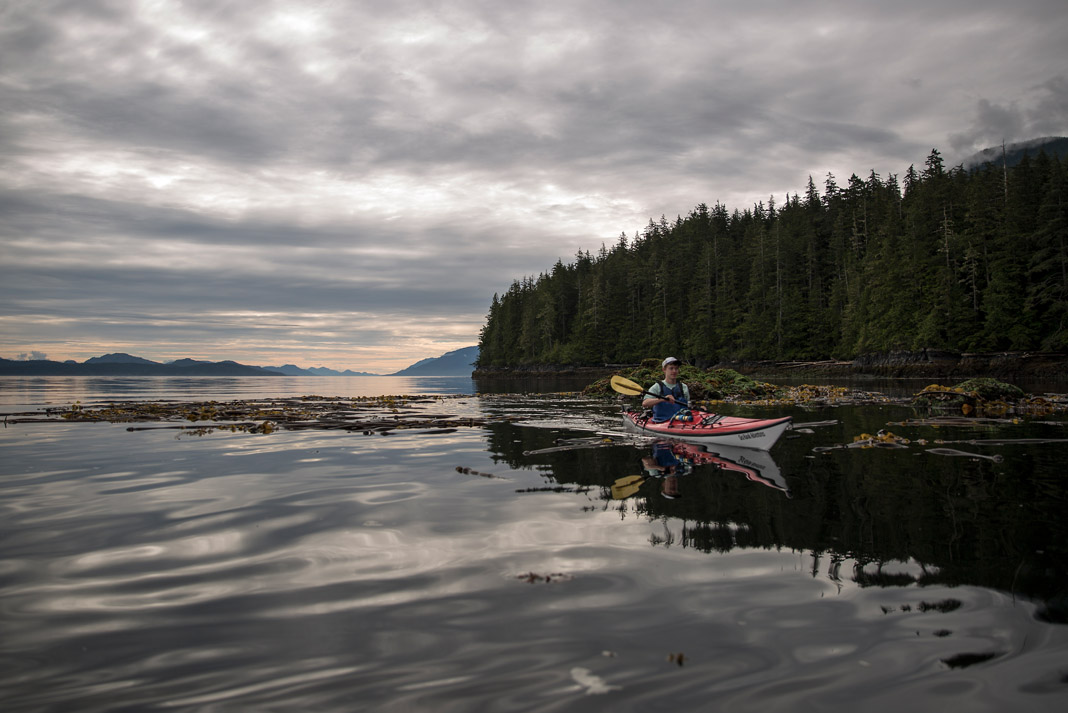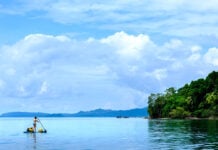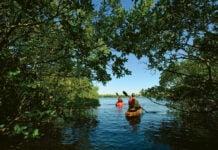Wildlife
Orcas, sea lions, humpback whales, eagles, bears, wolves, slugs, starfish, jellyfish and so much more.
Exposure
The wind can be strong, swell large and the weather changes on a dime. By staying close to shore you’ll never be far from shelter, just be prepared to camp an extra night or two if the weather is not agreeable. Beware of boat traffic when crossing the Strait.
Diversion
The Whale Interpretive Centre in Telegraph Cove is an excellent follow-up to your on-water sightings. Listen to vocalization recordings, learn about different types of whales and behaviors, and behold the epic size of a fin whale skeleton.
Outfitters
Multiple outfitters offer trips from several hours to several days in length, including BC Unbound, Sea to Sky Expeditions and Spirit of the West.
Must Have
Good rain gear is a must when visiting this temperate rainforest. Bring a waterproofed camera with a great zoom lens. Orcas, humpback whales and other wildlife may get close, but a 200mm zoom will assist you in getting excellent photos.
While kayaking in Telegraph Cove our guide calls out as a baby orca swims beneath my kayak, “It’s under us.” Closer to the rugged and rocky shoreline another orca breaks the calm ocean surface for a breath, while the remaining members of the pod slowly glide past our small flotilla.
They pay us little attention, far more concerned with making a breakfast out of the Pacific salmon inhabiting Johnstone Strait.
Just yesterday I witnessed a sea lion tear a salmon to shreds while a humpback whale put on a breaching show in the background. It sounded like a cannon being fired each time its 33-ton body hit the water, as impressive as anything I’ve ever experienced.
The secret is out.
Why has Telegraph Cove become a kayaking hotspot?
The small fishing village boasts relaxed vibes, quaint and colorful buildings and spectacular wildlife viewing. The unparalleled whale watching opportunities in Johnstone Strait are a particularly big draw.
Large motorboats and catamarans head out several times a day from the public dock crowded with tourists running from gunwale to gunwale hoping to catch a glimpse of mystical humpbacks and majestic orcas.
Kayaking allows for a much more peaceful and intimate experience with the whales. Not to mention the sea lions, bears and thousands of giant forest slugs calling this area home. Truly, they’re all amazing to see—even the slugs. With 40,000 islands making up the west coast of British Columbia, the options for trips of any length are limitless.

What to do while kayaking in Telegraph Cove
If you have a half-day:
Paddle in and around the small islands in the harbor at Telegraph Cove. Expect to see a bounty of marine life in tidal pools, inquisitive otters swimming by and bald eagles overhead.
If you have one day:
Explore remote beaches and rugged islands just outside the harbor. You might even spot a seal or two. A single day on the water here will awe you, and leave you wishing for much more.
If you have two to seven days:
Cross both Johnstone Strait and Blackfish Sound while keeping your eyes peeled for orcas, humpback whales and sea lions. More than 200 orcas call this area home each summer.
There are many islands to make camp on while kayaking in Telegraph Cove, but you may require a permit from the local Indigenous communities who lease the land to campers and outfitters.
This article was first published in Issue 53 of Paddling Magazine. Subscribe to Paddling Magazine’s print and digital editions, or browse the archives.









Great article.
Worth noting that there are Whale-Watching regulations to follows when watching wildlife from your kayak. These regulations can be found at various locations around Telegraph Cove. If in doubt speak with one of the kayak outfitters in either Telegraph Cove, Alder Cove or Port McNeill